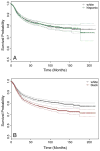Case-matching analysis of head and neck squamous cell carcinoma in racial and ethnic minorities in the United States--possible role for human papillomavirus in survival disparities
- PMID: 20848419
- PMCID: PMC3005025
- DOI: 10.1002/hed.21398
Case-matching analysis of head and neck squamous cell carcinoma in racial and ethnic minorities in the United States--possible role for human papillomavirus in survival disparities
Abstract
Background: Several studies have documented disparities in head and neck cancer outcomes for black patients in the United States. Recent studies have found that differences in oropharyngeal tumor human papillomavirus (HPV) status may be a cause of this disparity.
Methods: In all, 76,817 cases of head and neck squamous cell carcinoma (HNSCC) recorded in the National Cancer Institute's Surveillance, Epidemiology, and End Results (SEER) program were analyzed. Racial/ethnic groups were studied, for disease-specific survival in both case-matched and nonmatched cohorts. Calculation of expected disparity magnitudes based on HPV status was performed using data reported in the literature.
Results: A disease-specific survival disparity was demonstrated for Hispanic patients. However, case matching eliminated this disparity. Conversely, the disparity for black patients persisted in matched cohorts. The oropharyngeal subsite was found to be the dominant contributor to this disparity.
Conclusions: The survival disparity for Hispanic patients in SEER with HNSCC is explained by differences in presentation and treatment. Also, HPV tumor status is likely a key determinant of the disparity for black patients.
© 2010 Wiley Periodicals, Inc. Head Neck, 2011.
Figures



Similar articles
-
Racial Disparity Among the Head and Neck Cancer Population.J Cancer Educ. 2015 Sep;30(3):546-51. doi: 10.1007/s13187-014-0753-4. J Cancer Educ. 2015. PMID: 25398667 Review.
-
The prognostic role of sex, race, and human papillomavirus in oropharyngeal and nonoropharyngeal head and neck squamous cell cancer.Cancer. 2017 May 1;123(9):1566-1575. doi: 10.1002/cncr.30353. Epub 2017 Feb 27. Cancer. 2017. PMID: 28241096 Free PMC article.
-
Human papillomavirus genotype and oropharynx cancer survival in the United States of America.Eur J Cancer. 2015 Dec;51(18):2759-67. doi: 10.1016/j.ejca.2015.09.005. Epub 2015 Nov 18. Eur J Cancer. 2015. PMID: 26602016 Free PMC article.
-
Matched-pair analysis of race or ethnicity in outcomes of head and neck cancer patients receiving similar multidisciplinary care.Cancer Prev Res (Phila). 2009 Sep;2(9):782-91. doi: 10.1158/1940-6207.CAPR-09-0154. Epub 2009 Sep 8. Cancer Prev Res (Phila). 2009. PMID: 19737985 Free PMC article.
-
Immunometabolic Alterations by HPV Infection: New Dimensions to Head and Neck Cancer Disparity.J Natl Cancer Inst. 2019 Mar 1;111(3):233-244. doi: 10.1093/jnci/djy207. J Natl Cancer Inst. 2019. PMID: 30615137 Free PMC article. Review.
Cited by
-
Matched-pair analysis of the impact of low-dose postoperative radiotherapy on prognosis in patients with advanced hypopharyngeal squamous cell carcinoma without positive surgical margins and extracapsular extension.Front Oncol. 2023 Sep 7;13:1089275. doi: 10.3389/fonc.2023.1089275. eCollection 2023. Front Oncol. 2023. PMID: 37746267 Free PMC article.
-
Matched-pair analysis of patients with advanced hypopharyngeal cancer: surgery versus concomitant chemoradiotherapy.Int J Clin Oncol. 2017 Dec;22(6):1001-1008. doi: 10.1007/s10147-017-1151-9. Epub 2017 Jun 17. Int J Clin Oncol. 2017. PMID: 28624863
-
Neighborhood deprivation and clinical outcomes among head and neck cancer patients.Health Place. 2012 Jul;18(4):861-8. doi: 10.1016/j.healthplace.2012.03.005. Epub 2012 Mar 14. Health Place. 2012. PMID: 22445028 Free PMC article.
-
Disparities and guideline adherence for HPV testing among patients with oropharyngeal squamous cell carcinoma, NCDB, and SEER.Head Neck. 2021 Jul;43(7):2110-2123. doi: 10.1002/hed.26679. Epub 2021 Apr 13. Head Neck. 2021. PMID: 33851469 Free PMC article.
-
Racial Disparity Among the Head and Neck Cancer Population.J Cancer Educ. 2015 Sep;30(3):546-51. doi: 10.1007/s13187-014-0753-4. J Cancer Educ. 2015. PMID: 25398667 Review.
References
-
- Molina MA, Cheung MC, Perez EA, et al. African American and poor patients have a dramatically worse prognosis for head and neck cancer: an examination of 20,915 patients. Cancer. 2008;113:2797–2806. - PubMed
-
- Nichols AC, Bhattacharyya N. Racial differences in stage and survival in head and neck squamous cell carcinoma. Laryngoscope. 2007;117:770–775. - PubMed
-
- Hobbs F, Stoops N, Long JF. Census 2000 Special Reports: United States Census Bureau. 2002. Demographic trends in the 20th century.
-
- DeNavas-Walt C, Proctor BD, Smith JC. Current population reports: consumer income: United States Census Bureau. 2008. Income, poverty, and health insurance coverage in the United States: 2007.
-
- Rutledge MS, McLaughlin CG. Hispanics and health insurance coverage: the rising disparity. Med Care. 2008;46:1086–1092. - PubMed
Publication types
MeSH terms
Grants and funding
LinkOut - more resources
Full Text Sources
Medical

